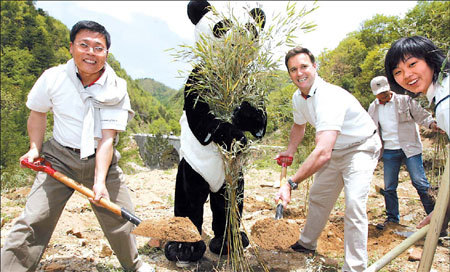When American Sophia Mendelsohn came to work in public relations for a Western firm in Shanghai three years ago, she realized then she'd never understand China's economic miracle from the firm's office tower. She'd have to see it from the ground level
 Australian Dermot O'Gorman, China's country representative for the World Wildlife Fund, plants bamboo with other volunteers on a panda corridor in the Qinling Mountains, Shaanxi Province.
Australian Dermot O'Gorman, China's country representative for the World Wildlife Fund, plants bamboo with other volunteers on a panda corridor in the Qinling Mountains, Shaanxi Province.
When the 25-year-old shifted to the manufacturing sector, she began touring local factories, talking to factory owners, floor managers, workers, container drivers and their families.
"In two-plus years, I saw two college funds raised, one house and one apartment purchased, an elderly father's life extended because his son could afford better doctors and two girls sent to high school in Shanghai," she says.
"But, these are the thin silver linings of a gray cloud, one that extends over all their improvement and happiness. It sits over the factories and has the faint smell of chlorine and fish - the pollution we see every day."
She began wondering if there were more sustainable ways to reap such social benefits. Her research led her to believe there were, but if change were to happen, she believed it would have to come from the youth.
So Mendelsohn joined the Shanghai branch of the youth-oriented environmental protection organization Shanghai Roots & Shoots and the swelling ranks of foreigners engaging in environmental protection work in China.
Roots & Shoots Shanghai director Tori Zwisler got involved with environmental work in the country after meeting renowned primatolgist-cum-conservationist Jane Goodall in 1998.
 American Anna Zimmermann powers compact fluorescent light bulbs by pedaling a bicycle during an event held by Global Village of Beijing on Earth Day.
American Anna Zimmermann powers compact fluorescent light bulbs by pedaling a bicycle during an event held by Global Village of Beijing on Earth Day.
Zwisler says Goodall asked her to help cultivate Roots & Shoots programs around Shanghai. When she started in 1999, three local schools were involved in the program. Today, there are more than 170 programs. Members participate in a variety of projects that range from making their schools environmentally friendlier to planting trees in Inner Mongolia autonomous region.
Zwisler says the 2006 Inner Mongolia reforestation project was made a "great experience" by support and camaraderie.
"We have taken a unique approach, working with the local farmers, nursery seedling suppliers and school children to form a team that will not only plant the trees but also monitor their survival, their growth and their value, and build a program that will last for the next 45 years."
The organization pledged to plant one million trees in the desert encroaching on Hure Banner in southeastern Inner Mongolia and expects to meet that goal by 2016, she says.
"Our tree planting program is a great example of how unique China is: We can plant trees and change the desert from a brown, sandy wasteland to a green, crop-sustaining forest and at the same time improve the economy of a whole village - all through the organized support of people throughout China who care enough to buy trees," Zwisler says.
One of the most rewarding things about her work in the country is helping Chinese youth discover their own abilities to change the world, she says.
"By careful mentoring and positive reinforcement, we develop projects that show the students that they can have a positive effect on pollution, climate change, recycling things or improving areas in need," Zwisler says.
Australian Dermot O'Gorman, country representative for the World Wildlife Fund (WWF), says the Chinese zeal for greening up their act makes the country a unique place to work on environmental projects.
"The energy in China at present is fantastic; there is real enthusiasm to address the environmental problems and to find practical solutions," O'Gorman says. "It is very exciting to be here at this time when the foundations are being laid for the future."
O'Gorman worked for WWF, which currently runs 40 projects in China, for 10 years before coming to Beijing in 2005.
"My experience with WWF is that China is very keen both to learn from other countries and also to share their successes with their neighbors," he says. He says he's found it easy to work with Chinese environmentalists because "scientific language is one thing that does cross well between different cultures".
American Anna Zimmermann, who came to China on a Fulbright Research Grant to study both Mandarin and environmental education, says working on ecological issues has the ability to serve as a cultural bridge.
"Working on the environment has been a really powerful way to meet more Chinese people with similar interests," she says.
Since last September, the 23-year-old has been working with Global Village of Beijing (GVB) to design exhibitions and programs for an environmental education center the organization plans to open in Beijing's Yanqing district.
While she often finds foreigners and Chinese share a common desire to protect the environment, they usually face different challenges in their home countries.
"In the United States, a lot of problems come from problems of high consumption - everyone's got a car, people live in big houses - but in China, a lot of the issues come from the monitoring of pollution from manufacturing and large-scale issues, such as the use of coal," Zimmermann says.
But, as Mendelsohn sums up, most foreigners working on environmental issues in China do so because they view them as global concerns. She says much of the country's pollution results from the demand for manufactured goods from their home countries.
"We cannot afford to think of this as 'China's problem'," she says. "This is not what 'they have done to their country'; this is the system we have collectively created."
(China Daily July 1, 2008)